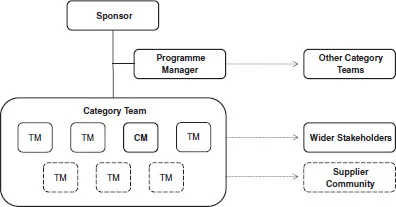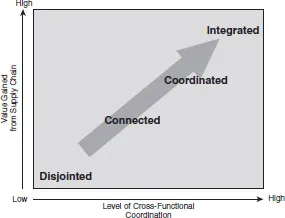![]()
Stage 1
Initiation
Overview and benefits of this stage
Why start with governance, and why not simply ‘get on’ with category management?
There is a desire within many organisations to ‘rush’ into category management and to ‘execute at pace’. This is ill-conceived if an organisation is looking to make major changes and create significant lasting benefits. It is logical to assume that most of the obvious opportunities for commercial improvement have already been taken; otherwise, why engage in category management? So the main reason why organisations are adopting category management should be because they are looking for a step change in delivery.
In category management this is referred to as breakthrough thinking. Category management has the ability to bring together a wide number of stakeholders and to get the organisation thinking and behaving strategically towards managing its expenditure. Typical outcomes from breakthrough thinking might include new product development, business process reengineering, supply-base rationalisation, value engineering, business process outsourcing, supply-chain integration and so on. These are not small-scale incremental changes (such as renegotiating a contract) but should be aimed at delivering large-scale improvement.
It is difficult to quantify these improvements to a single figure, but if cost reduction was the only measure, then a stretching target of at least 20%–25% might be considered. However, as is widely recognised amongst leading experts, category management is far more sophisticated than a one-dimensional focus on cost.
Given the level of challenge in these targets for category management, together with the complexities of a modern-day organisation, Stage 1 (Initiation) represents a critical set of preparation activities for all category management teams. Those who overlook or underplay this initial stage fail to understand how strategic change programmes are successfully delivered in modern organisations. The future strength and sustainability of deliverables rest completely on the rigour that has been applied to this first step.
Put simply, Stage 1 (Initiation) is about setting up and initiating the category review with best-practice project management disciplines. It is about corralling all of the necessary stakeholders across the organisation to focus and agree on a strategic plan of action for a given area of organisational spend. If the category is not given this sense of structure, profile and importance, then it will fail to carry sufficient momentum during the analysis and strategy stages and will be unlikely to deliver meaningful benefits.
Extra explanation and theory
The activities in this stage are about embedding a sense of governance into the management of the category. Some practitioners and consultants will refer to category management as a project, as discussed in this book’s introduction. While this isn’t strictly true and (wrongly) suggests that category management has an end point (rather than being continuously iterative), this type of thinking can be helpful when setting up and organising a team to review the category, devise a new strategy, implement change and deliver benefits.
One of our clients recently described governance as ‘the right people, making the right decisions, at the right time with the right information’. It’s a nice summary, but let’s not get misled that this is simple.
Governance needs to cover scoping boundaries, accountabilities and decision rights. This requires a competence in managing stakeholders, and the activities within this step are predominantly focused on this essential task. Defining the project team and its wider stakeholder team is critical. Category management is a cross-functional activity designed to bring together the organisation to analyse and agree on the best strategy going forwards. This means that getting the right representation onto the category team is critical.
Many organisations now adopt a three-tiered approach to category team governance, as illustrated in Figure 1.1.
Selecting and co-opting the category sponsor is fundamental. This should be a senior manager at executive/director level in the organisation with the appropriate authority to give the category team the ‘mandate’ required to operate. Typically this is not a procurement person, especially if an enterprise-wide solution is required. It might be an operations director, the SVP marketing, the CIO/CTO, a chief engineer or any similar senior role that is relevant to the type of spend that’s under review.
The sponsor needs to be briefed and co-opted into their role, which will require a commitment of their time to take on a ‘figurehead’ leadership role and be the chief point of accountability for the category team (similar in many ways to the role of a senior responsible officer in the public sector). This will include regular briefings (typically on a monthly basis) and approvals for the gateway reviews.
Programme managers are only required where there are several categories under review at any one time in an organisation. Principally their role is one of coordination, management, reporting and resourcing. They should not be directly involved in the day-to-day detail of the category team.
Figure 1.1 Three-tiered governance
If an organisation is engaging consultants to help adopt category management, the programme manager does not need to be from the same consultant company. Any competent and experienced commercial project manager is capable of fulfilling this role.
The category team should therefore comprise a number of team members (TM) or representatives from relevant functional disciplines that are involved with the spend. For example, a category team reviewing packaging expenditure might include the packaging buyer and representatives from production, marketing, logistics and finance. The team would not include anyone from the supply community (i.e. no suppliers), nor anyone else with a conflict of interest.
The category manager (CM) is selected from within the team and his or her management/coordination role is approved by the sponsor. In less mature organisations, category managers are not full-time roles (and neither is the membership of the category team). However, more mature category management often necessitates full-time resource commitment – especially for higher-value and more complex categories.
The level of cross-functional coordination in a category is directly proportional to the amount of value that can be derived from the supply chain, as illustrated in Figure 1.2.
In practice, although practitioners would like to think they can launch a category management initiative and gain ‘breakthrough’ commercial benefits, the reality is that first-generation category management rarely does. It is often a disjointed response.
The iterative approach to category management takes a longer-term, more strategic view of spend management, recognising that commitment needs to be built up across the organisation before large-scale change can be effected successfully. Only a fully ‘integrated’ approach to category management will deliver enterprise-wide breakthrough success. Sometimes this only occurs on the second, third or fourth generation (iteration) of category management.
Figure 1.2 Category maturity matrix
Practical hints and tips
- 1 Take time to select team members who are committed to change and supporters of the category management approach.
- 2 Teams need to be given time to form and perform. If you need major breakthrough results from a committed team, then consider an appropriate team-building activity.
- 3 Briefing roles, responsibilities and scope is essential. Everyone needs clarity, both inside and outside the category team.
- 4 ‘Mindset’ is a key attribute that can unlock value, so it helps to have free thinkers and a ‘can-do’ attitude in the team. That said, a diverse team usually performs better!
- 5 Take time to brief the sponsor and gain his or her commitment to the cause.
- 6 Avoid conflicts of interest and prejudice about the end solution.
- 7 Be prepared to commit time and resources to the category management approach. The end-to-end process may take an iteration of 8–16 weeks (depending on category complexity, sometimes longer) and Stage 1 can take as long as 6 weeks to set up correctly.
- 8 Take a project management approach to resourcing and coordinating activities within the category process, even though it’s not a project!
Summary of activities
We have detailed seven key activities within this first stage of category management:
- 1 Project charter – This is a simple summary document that defines the scope, resources and objectives of the category review.
- 2 Category hierarchy – This is a classification system that applies across the full organisational spend profile so that the category can be defined and scoped and that all interfaces with other areas of spend are identified.
- 3 Team charter – This summary document identifies the roles, responsibilities and behaviours of the category team to ensure commitment and unity of purpose.
- 4 RACI – This is a summary that charts each of the stakeholders and his or her respective involvement within the category.
- 5 Stakeholder management – This is an approach to identify, classify and subsequently manage each of the internal (or external) stakeholders within a category.
- 6 Communication plan – To support the stakeholder map, this document summarises each of the planned communications to support category activity and progress.
- 7 Risk register – This is an application of best-practice project management disciplines to the category in terms of identifying, assessing, logging and mitigating key risks to delivery on the category.
What the gateway needs to consider
As outlined in the introduction to this handbook, we recommend a specific approval point at the end of each stage that we refer to as a ‘gateway’. Ideally this should be treated as a ‘go/no-go’ gateway, particularly for Stage 1 (Initiation) where the emphasis must be on whether the category governance has been set up appropriately for the ensuing category activities.
Specifically, this needs to ensure that the category review has been appropriately scoped and resourced. It needs to check that project management disciplines have been embedded in the category and the right personnel are on board with a clear vision and understanding of their roles and what activities they need to undertake. On top of this, it is...


